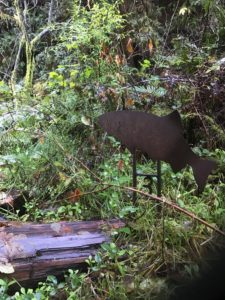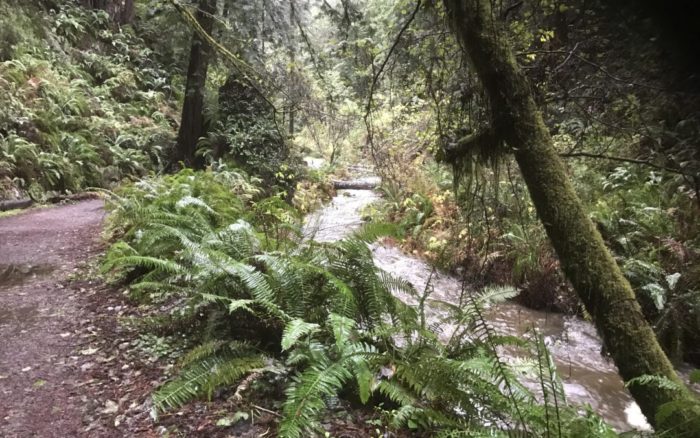Path of Man and Path of Salmon
Fern Creek rose in the night with the punishing rain. The log jams are now dams pouring water, bruising, but still navigable— for a coho salmon. Walking along the trail that traces Fern Creek, I watch for the iron fish, each with a number. I have seen as many as three, up to the number 6, but because the fish are rusted, they blend in and are hard to see. At first I thought an artist had decided to leave a message with his or her installation, but then I realized this is a place juvenile and returning salmon are probably counted each season. This is an area that humans are carefully monitoring.

Metal salmon along Fern Creek.
We have done so much to destroy salmon habitat, and never more so than on the north coast. Within the last 150 years we have cut 99% of old growth redwoods. This is particularly poignant walking through the forest of second growth along Fern Creek. The trees stretch forever to the sky, the forest, cold and damp. You feel dwarfed, cautious. What else is here? What is that smell of musk that has marked the bridge over a feeder creek? A coyote— or mountain lion? Here you are reminded of your place in the food chain.
And yet, as your eyes accommodate to the darkened conditions, you see the shadows of fire-blackened redwood stumps whose girth dwarfs that of their offspring. What could we have been thinking to kill millions of these gigantic beings? In very few protected areas they still exist, but very few escaped the saws. With the cutting of these redwoods, the temperatures of the North Coast have risen.
The coho salmon are an integral part of this forest and their populations have been profoundly impacted by our thoughtless clear cutting of the redwood giants, by our damning of rivers, and taking waters for irrigation. The salmon runs were critically important for First People of the North Coast: the Yurok and the Hupa; the Pomo and the Miwok. It is said you could walk across the creeks on the salmons’ backs, they were that numerous. Bear, mountain lions, and coyotes feasted on these fish. Osprey carried them to their nests on the tops of redwoods. Salmon bones and carcasses nourished the soils. Salmon were a source of sustenance to so many beings—a keystone species.
I have not seen one fish in the five days that I have walked this stream, although I think this is the traditional time of the salmon runs here. And yet, I take heart in seeing the rusted effigies of the coho along the trail. Finally, we are witnessing what has happened, what is happening, and hopefully learning the intricacies of interconnections of all beings. This is a different paradigm from that we have lived over the last centuries. It is the challenge of climate change: can we meet it soon enough to make life possible into the future?
